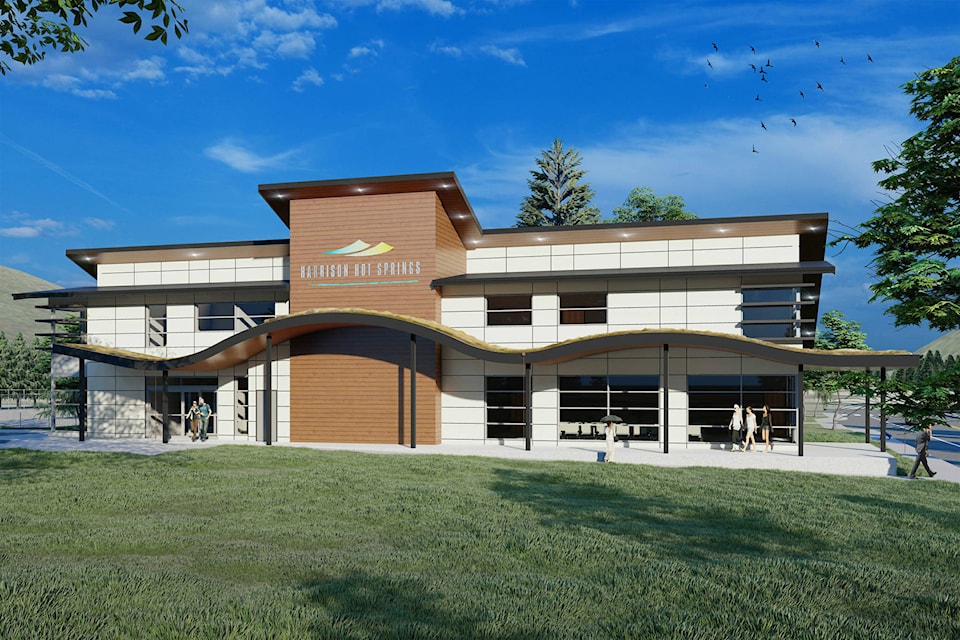Harrison could be home to a new civic and cultural hub, if a grant application put forward by the village goes through.
On Monday (Jan. 7), Harrison council voted to submit a funding application of up to $4 million in order to solve what CAO Madeline McDonald called “pretty serious limitations” to the current village office.
The office, which is in the historic MacPherson House, was donated to the village in 1979 and has gone through a number renovations in an attempt to make municipal operations fit in the building.
Currently, the CAO and infrastructure manager are working out of a Britco trailer in the office parking lot; the staff lunch room and storage spaces have been transformed into offices. Archived files have been moved to commercial storage in Agassiz, and the only meeting space is in the council chamber.
“Unfortunately, I have staff that are bending down, pulling out files — I’m putting it as nice as I can — with somebody in the washroom,” Mayor Leo Facio said during council. “I don’t think that’s a very healthy environment to be in.”
When the Investing in Canada Infrastructure program was announced by the provincial and federal governments in 2018, the village saw an opportunity to create a new space for administrative and public use.
The proposed multi-purpose civic building would have a “public gathering space,” which would include a washroom and kitchenette, as well as room for “cultural sharing” with the Sts’ailes First Nations and pop up heritage exhibits from the Agassiz-Harrison Museum.
The building would also have the council chambers, which would moonlight as a theatre space. The second floor of the building would be reserved for administrative staff space. The roof would be made of solar panels, which would power the building and return extra electricity to the grid.
Facio is also advocating for a roof garden on the second floor of the building, although it’s not included in the current plans.
The cultural spaces in the building are what make Harrison’s application eligible for the Investing in Canada Infrastructure program, as the fund can only be used for community, cultural or recreational spaces — not civic ones.
McDonald said staff have spoken with provincial staff in the Department of Municipal Affairs and said the application would be okay to go forward if the village separated out the parts of the project that were dedicated for municipal use.
“It would be a very cost effective way to create a building where we could realize administrative office space that works for the village, while providing a new community amenity,” McDonald said.
The ratio of administrative offices and public spaces already is causing some consternation in the community. Harrison resident Marg Doman spoke out during the question period in council Monday, saying there wasn’t enough space for the people.
“I’m a little bit disappointed,” she said. “The majority of it is for council offices and the chamber.”
“I would really, really, sincerely appreciate if you could look at it again, use the money wisely and make sure you look to the future, not just to have a garden upstairs,” she added.
After some back and forth between Doman and Facio on whether there was enough cultural space, and whether a roof garden was the best use of resources, councillor Gerry Palmer chimed in.
“I share your concern about making sure there’s amble public and gathering space,” he said to Doman. “I think you can be comfortable that we’re all going to be looking at that very carefully.”
Minor changes to the conceptual drawings are possible, McDonald said, so long as the total project cost remains within the budget submitted with the application.
The project is expected to cost around $4.8 million, with about $1 million being ineligible for grant funding as the costs relate to the administrative parts of the building.
If the application is successful, provincial and federal governments will pay up to 73 per cent of the eligible cost, leaving Harrison with a total $2 million bill.
This is something the village could pay for out of its surplus, McDonald said, so long as the village sold off municipal land to repay those funds at a later time.
Possible lots that could be sold include portions of the overflow parking next to the village office (495 Hot Springs Road).
Councillor Ray Hooper worried that selling those lots could create parking problems for nearby residents, as visitors leave their vehicles in front of homes instead of in the lot.
“The way the village has developed at the moment … people who use the car park will now be parking in residential areas, which will cause a problem,” he said. “What I don’t want to see is a knock on affect to the residents with inappropriate parking.”
RELATED: Pay parking returns mid-June
Although Facio said the village had dedicated land at the end of Lillooet Street that will be cleared for parking, that did not convince Hooper the problem wouldn’t arise. Hooper still voted in favour of submitting the application, despite his parking concerns.
If the application is accepted, the new centre would be built next to the current administrative building. The MacPherson House would then be made available to other organizations in the community.
The deadline for submissions to the Investing in Canada Infrastructure program is Jan. 23. The Village of Harrison would hear back with the result of their grant application sometime after that.
grace.kennedy@ahobserver.com
Like us on Facebook and follow us on Twitter
